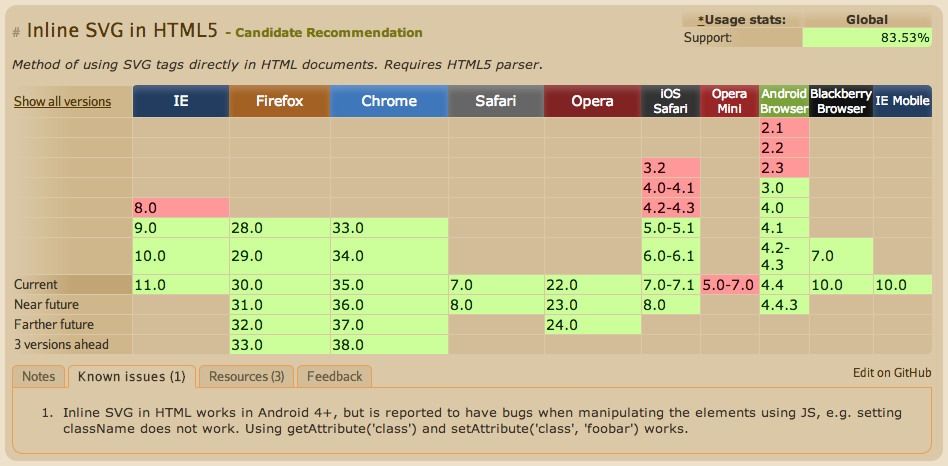Getting started with inline SVG
This May, Viget worked with Dick's Sporting Goods to launch Women's Fitness, an interactive look at women’s fitness apparel and accessories. One of it's most interesting features is the grid of hexagonal product tiles shown in each scene. To draw the hexagons, I chose to use SVG polygon elements.
I've had experience using SVG files as image sources and in icon fonts, but this work was my first opportunity to really dig into it's most powerful use case, inline in HTML. Inline SVG simply refers to SVG markup that is included in the markup for a webpage.
<div><svg><!-- WHERE THE MAGIC HAPPENS. --></svg></div>
Based on this experience, here are a few simple things I learned about SVG.
1. Browser support is pretty good
http://caniuse.com/#feat=svg-html5

2. SVG can be styled with CSS
Many SVG attributes, like fill and stroke, can be styled right in your CSS.
See the Pen eLbCy by Chris Manning (@cwmanning) on CodePen.
3. SVG doesn't support CSS z-index
Setting the z-index in CSS has asbolutely no effect on the stacking order of svg. The only thing that does is the position of the node in the document. In the example below, the orange circle comes after the blue circle in the document, so it is stacked on top.
See the Pen qdgtk by Chris Manning (@cwmanning) on CodePen.
4. SVG can be created and manipulated with JavaScript
Creation
Creating namespaced elements (or attributes, more on that later) requires a slightly different approach than HTML:
// HTML
document.createElement('div');
// SVG
document.createElementNS('http://www.w3.org/2000/svg', 'svg');If you're having problems interacting with or updating elements, double check that you're using createElementNS with the proper namespace. More on SVG namespaces.
With Backbone.js
In a Backbone application like Women's Fitness, to use svg or another namespaced element as the view's el, you can explictly override this line in Backbone.View._ensureElement:
// https://github.com/jashkenas/backbone/blob/1.1.2/backbone.js#L1105
var $el = Backbone.$('<' + _.result(this, 'tagName') + '>').attr(attrs);I made a Backbone View for SVG and copied the _ensureElement function, replacing the line above with this:
// this.nameSpace = 'http://www.w3.org/2000/svg'; this.tagName = 'svg';
var $el = $(window.document.createElementNS(_.result(this, 'nameSpace'), _.result(this, 'tagName'))).attr(attrs);Setting Attributes
- Some SVG attributes are namespaced, like the href of an image or anchor:
xlink:href. To set or modify these, use setAttributeNS.
// typical
node.setAttribute('width', '150');
// namespaced
node.setAttributeNS('http://www.w3.org/1999/xlink', 'xlink:href', 'https://viget.com');- Tip: attributes set with jQuery are always converted to lowercase! Watch out for issues like this gem:
// jQuery sets 'patternUnits' as 'patternunits'
this.$el.attr('patternUnits', 'userSpaceOnUse');
// Works as expected
this.el.setAttribute('patternUnits', 'userSpaceOnUse');- Another tip: jQuery's
addClassdoesn't work on SVG elements. And element.classList isn't supported on SVG elements in Internet Explorer. But you can stil update the class with$.attr('class', value)orsetAttribute('class', value).
5. SVG can be animated
CSS
As mentioned in #2, SVG elements can be styled with CSS. The following example uses CSS animations to transform rotatation and SVG attributes like stroke and fill. In my experience so far, browser support is not as consistent as SMIL or JavaScript.
Browser support: Chrome, Firefox, Safari. Internet Explorer does not support CSS transitions, transforms, and animations on SVG elements. In this particular example, the rotation is broken in Firefox because CSS transform-origin is not supported on SVG elements: https://bugzilla.mozilla.org/show_bug.cgi?id=923193.
See the Pen jtrLF by Chris Manning (@cwmanning) on CodePen.
SMIL
SVG allows animation with SMIL (Synchronized Multimedia Integration Language, pronounced "smile"), which supports the changing of attributes with SVG elements like animate, animateTransform, and animateMotion. See https://developer.mozilla.org/en-US/docs/Web/SVG/SVG_animation_with_SMIL and http://www.w3.org/TR/SVG/animate.html for more. The following example is animated without any CSS or JavaScript.
Browser support: Chrome, Firefox, Safari. Internet Explorer does not support SMIL animation of SVG elements.
See the Pen jtrLF by Chris Manning (@cwmanning) on CodePen.
JavaScript
Direct manipulation of SVG element attributes allows for the most control over animations. It's also the only method of the three that supports animation in Internet Explorer. If you are doing a lot of work, there are many libraries to speed up development time like svg.js (used in this example), Snap.svg, and d3.
See the Pen jtrLF by Chris Manning (@cwmanning) on CodePen.
TL;DR
SVG isn't limited to whatever Illustrator outputs. Using SVG in HTML is well-supported and offers many different options to style and animate content. If you're interested in learning more, check out the resources below.
Additional Resources
- Using SVG by Chris Coyier
- An SVG Primer for Today's Browsers (in-depth primer, lots of code examples and visual aids)
